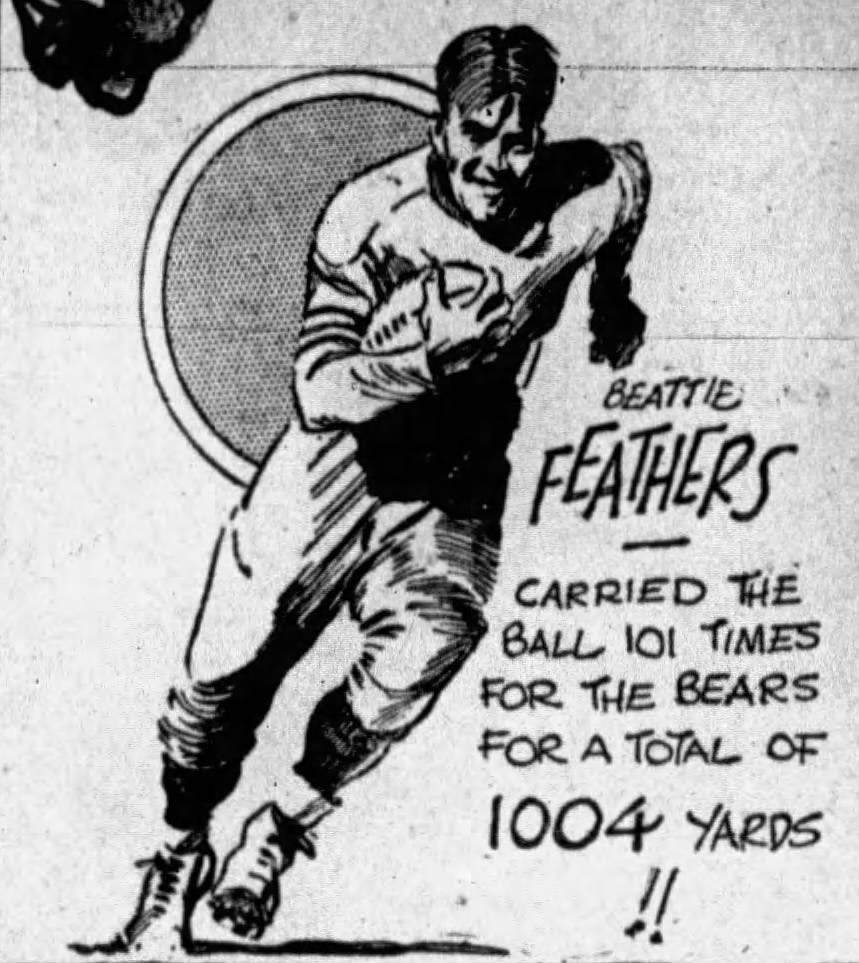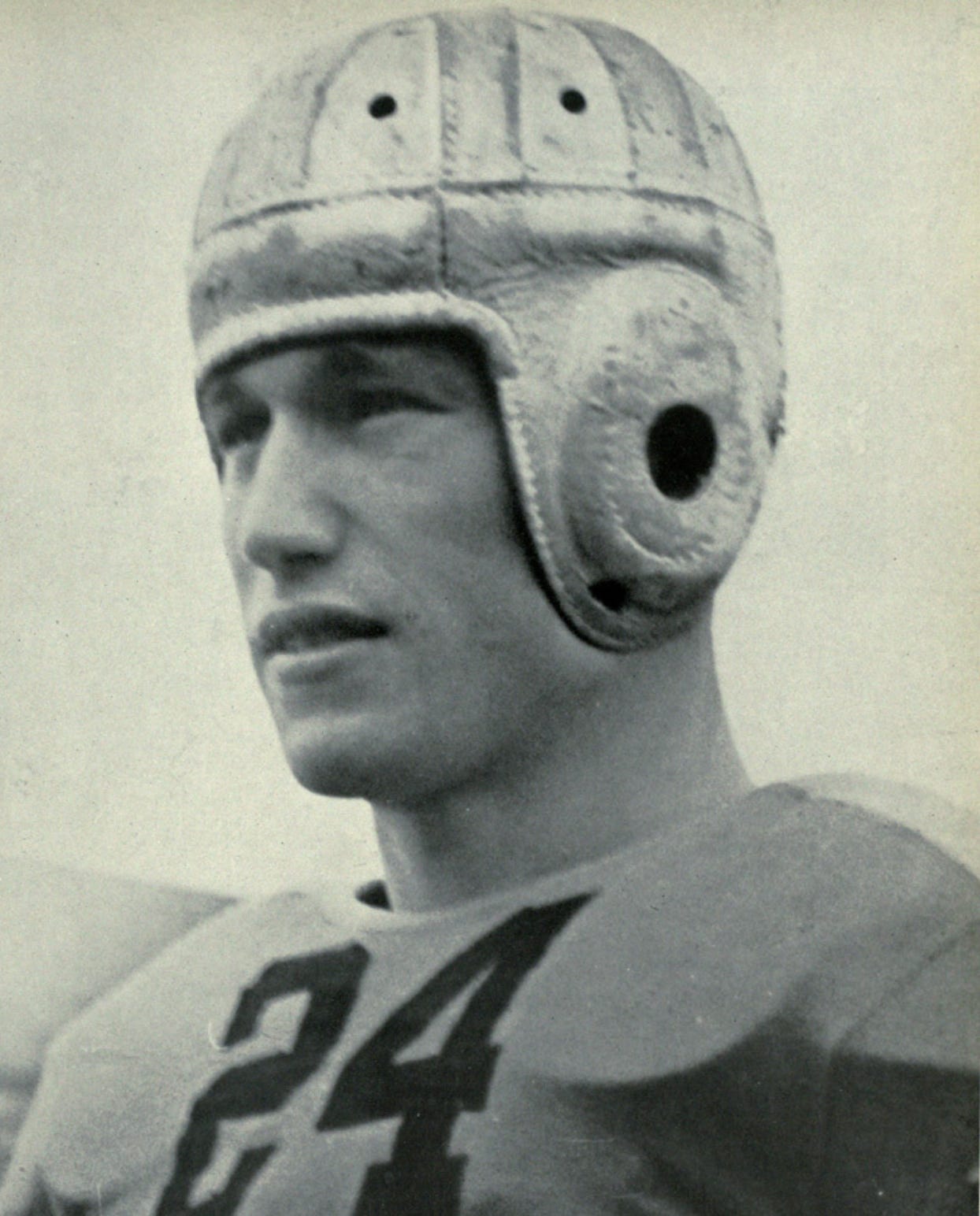Terminology: 1,000-Yard Rusher
I started publishing Football Archaeology 1,000 days ago today, so applaud if you must, but that realization led me to return to a favorite theme: the emergence of football terms. I chose to investigate the origins of the "1,000-yard rusher," which was once among the highest achievements in football.
My third book, Hut! Hut! Hike!, investigated the origins of 400+ football terms, but 1,000-yard rusher was not among the chosen 400. There was only so much room in that book, so I skipped it and other terms, but there's no time like the present to remedy the situation.
In the book and today, I define the origins of football terms based on when they first appeared in a newspaper. I figure that most football terms originated with coaches, who used them when talking to the press, and reporters passed them on to John Q. Public in their writing. Terms sometimes appear in other publications first; I credit them when possible. Still, there are lots of newspapers consolidated in searchable databases, so there is a method to the madness.
The questions then become, when did football players first rush for 1,000 yards in a season, and when did someone first use "1,000-yard rusher" to describe that accomplishment? What's your guess? When do you think the term first appeared?
Your estimate should consider several factors, including the following:
Football was a low-scoring game for many decades, with teams often using their punters to gain a field position advantage rather than their offenses. Rushing yards were hard to come by back in the day.
Offenses were heavily restricted, especially in the passing game. As restrictions on the passing game eased in the 1930s, the forward pass became more effective, which opened up the running game.
Offenses historically had four players in backfield positions until flankers and the pro set became popular in the 1950s and 1960s. With four in the backfield, teams spread their rushing attempts across three or four backs rather than one or two, as happens today.
Teams at all levels played fewer games per year than today, which led to fewer rushing attempts per season.
College football did not begin keeping consistent stats until 1937, and it took a few years for everyone to submit them. NFL game statistics started in 1932.
The lack of consistent statistics meant that people, even writers, paid them less attention and trusted stats less. The statistical horse races of modern football did not exist or were less salient.
Of course, there came a time when some combination of the listed conditions was overcome, or a runner was so outstanding that he rushed for 1,000 yards in a season, but that did not ensure someone used the term "1,000-yard rusher" in print.
So, after considering the abovementioned factors, what's your guess now? When did "1,000-yard rusher" first appear in print?
It turns out that the term premiered when a columnist looked back at the Oklahoma Sooners’ 1952 Big Seven championship season under Bud Wilkinson. The 1952 Sooners went 8-1-1, tying Colorado in the season opener, losing at Notre Dame, and demolishing all others. Billie Vessels led them on the field, earning the Heisman Trophy by gaining 100+ yards in seven games and 1,072 yards on the season. His backfield mate, All-American fullback Buck McPhail, gained 1,018 that season, making them the first backfield combo in college football to each gain 1,000 yards in one season.
In his season wrapup, columnist John Cronley of the Daily Oklahoman noted the Sooners' dynamic duo of 1,000-yard rushers were exceptional since only three Big 7 players had managed the feat to that date.
The term next appeared in the same newspaper nine months later when another reporter, Don Pierce, wrote about the Sooners' dual threat as he projected how the Sooners might do in 1953.
The term only appeared a few more times in the 1950s, mainly to describe the achievements of high school running backs, but a 1957 article told us that Wagner's John Mangiante entered the last game of the season needing one yard to reach 1,000. By breaking off a 13-yarder early in the game, he became the school's third 1,000-yard rusher and the first to be identified as such in print. Why the first two did not receive the designation is anyone's guess.
So, while Oklahoma had the first two designated 1,000-yard rushers, what do the record books tell us about who first gained 1,000 yards in a season and had the official statistics to back up the claim?
Beattie Feathers was the first NFL player to crack the 1,000-yard mark when he did so in 1934, bettering the league's previous rushing record by almost 300 yards (in 13 games).
The colleges began keeping statistics in 1937, and for the first several years after that, the Football Guide and Rule Book did not report season-rushing stats for individuals, focusing instead on the longest plays and high-point scorers. However, they reran the stats in 1942, and that year’s Football Guide and Rule Book listed three notable individuals in the season-rushing record table.
Frank Sinkwich, the 1942 Heisman winner, held the record for most rushing attempts, while UCLA's Jackie Robinson had the highest average per play. The record holder for most yards in a season was the future Supreme Court Justice Byron "Wizzer" White, who logged 1,121 yards during the 1937 season.
Someone else may have reached 1,000 yards during the 1937 season before White, and others may have done so in the seasons before official statistics were kept. Still, Wizzer is not a bad guy to consider for the honor of being the first college 1,000-yard rusher.
So, how accurate was your guess regarding the first use of "1,000-yard rusher?” Knowing when college statistics began, I had assumed the term arrived by the mid-1940s, but that was not the case.
Let me know if there are other football terms to investigate that were not covered by Football Archaeology or Hut! Hut! Hike!, which you can read for free with Kindle Unlimited.
Click here for options on how to support this site beyond a free subscription.









Another detractor from having a 1,000-yard rusher was the timing of games prior to lit fields. Many times, as you have pointed out in previous Tidbits, the second half was shortened, especially late in the season, to avoid darkness.
Today's (pro) football color 'casters use a Fibber McGee's closet of terms to describe each play, leaving me stupefied ..